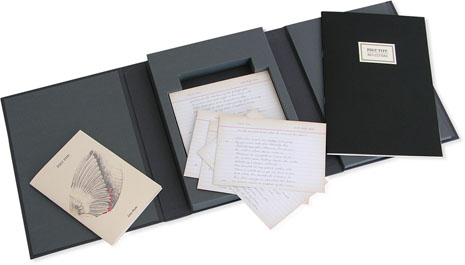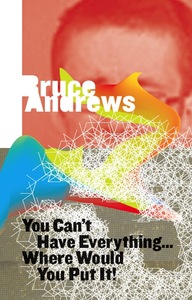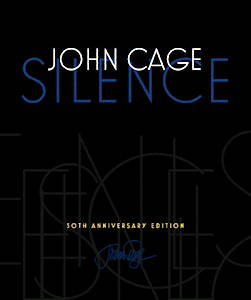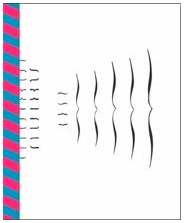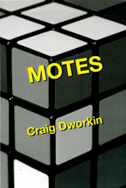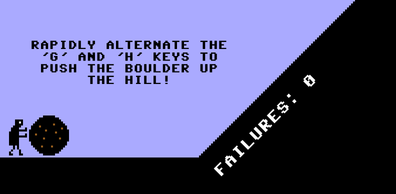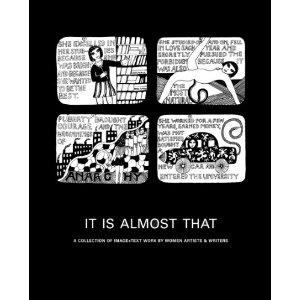Dear Mr. Montfort,
I do not want to cause offense, merely offer a suggestion: would you
consider removing the parts of your blog that clearly do not deal with
interactive fiction from “Planet IF” (http://www.planet-if.com)?While I am not saying that your posts are not intersting or that the term
“interactive fiction” should only apply to text adventure games in the
narrow sense (and while I appreciate the articles on Game Design and other
forms of interactive fiction that appear on Planet IF), the sheer volume of
your blog posts, along with “Grand Text Auto”, sometimes tends to drown out
anything else.…
Big Questions
Radical Books of 2011, 10/10
Big Questions, Anders Nilsen, Drawn & Quarterly, 9781770460478
Anders Nilsen has done exquisite sequential art, a.k.a. comix. I’m particularly fond of the trembling outlines and barely-representational figures in The End. The trade book of Big Questions is more conventional in style, but it binds 658 pages and 15 volumes of Nilsen’s work together in an extended, amazing story. In it, birds speak, but aren’t very smart. They devise their own ideas about a piece of unexploded ordnance, for instance, imagining it as an egg. An elderly woman dies in a plane crash; the idiot man-boy she has been caring for survives, as does the pilot. He also doesn’t seem too smart. The drawing style, which passes for simple at times but is nicely composed and filled with rich details, keys into the story, an animal tale that passes beyond childish simplicity. There are none of the mainstream superheros and no hint of the indie comics memoir in these ten years of work by a master of this art. Comic readers should love it; radical readers who wish to try out comics should try it.
Pale Fire: A Poem in four Cantos by John Shade
Radical Books of 2011, 9/10
Pale Fire: A Poem in four Cantos by John Shade, Vladimir Nabokov, Ginkgo Press, 9781584234319
Extracting the poem (which only exists as a sort of in-joke in the radical novel Pale Fire) from what is perhaps (according, e.g., to Larry McCaffrey) the major English-language novel of the 20th Century? It’s at least a very extreme move. This edition drops the prose like a bad habit, makes like a banana and splits it off, makes like a tree and abandons House of Leaves prose for Leaves of Grass verse. Does it work in the sense of presenting a beautiful poem freed from its chrysalis? No. Much of it is still most notable for building up, and then comically deflating, the explicitly implied author, John Shade. It’s better as part of a narrative than as language trembling between sound and sense. But John Shade’s “Pale Fire” is not too bad of a poem qua poem, and reading it alone can certainly enhance one’s appreciation of the truly incredible novel that has been shucked off here. I haven’t read the included commentary, but must note that including commentary is an absolutely hilarious idea.
You Can’t Have Everything… Where Would You Put It!
Radical Books of 2011, 8/10
You Can’t Have Everything… Where Would You Put It!, Bruce Andrews, Veer Books
There is no way this book will get past your spam filter:
facework cootie itsier-off
we are the dream sequences in your conventional cultural life –
Indeed we are. Here’s verbal salad (French dressing? Russian dressing?) shot through at times with lines of split and reassembled words:
zy^rit
sect^in
sing^franchi
cres^offi
It’s a delight to apprehend such text, passing words beneath one’s eyes, thinking about what it all might mean and sound like. Looking back now, I wonder if I should have flipped this open and read at random when I encountered it originally. Instead of plodding through, I might have thought for days about a line such as “tractor the Real.” But, as it happens, I can still do that. Although I have everything, I had nowhere to put it. I have to delve in again for specific examples of juxtapositions that Bruce Andrews fashions. The book is no doubt worth reading, scanning, or hashing into – however you want to have it all.
I Thought It Was Art, Man
But my credit card company says otherwise…

E-Lit Platforms at the MLA
Dene Grigar, vice president of the Electronic Literature Organization and one of the organizers of the excellent e-lit gallery and reading here at the MLA Convention, just gave a great presentation about the importance of platform in the development and reception of electronic literature. I was pleased initially to see that there was not only this presentation with “Platform” in the title, then very interested to hear about her work in a lab with original older computer hardware and her discussion of platform differences and changes through the years.
Even more surprising is that Ian Bogost and I have managed to advance part of our diabolical plan to have people use five long, colored rectangles stacked on top of each other:

Silence: Lectures and Writings
Radical Books of 2011, 7/10
Silence: Lectures and Writings, John Cage, 50th anniversary edition, Wesleyan University Press, 9780819571762
Stefan Helmreich and I were at dinner with a group and started talking about John Cage. The anechoic chamber Cage visited at Harvard is no longer there. MIT doesn’t have one, either. The best you can do (as a visiting sound artist found out) is arrange to visit Bose headquarters in Framingham, where they have a scruffy, industrial room – completely unlike the pure, science-fictional, sound-proof capsule a visitor would no doubt imagine. The point of Cage’s anechoic chamber story is that he heard a low-frequency and a high-frequency sound when he was in it; this was the circulation of his blood and the sound of his nervous system. This experience suggests we cannot truly hear silence, since we always produce sounds. Stefan suggested that perhaps profoundly deaf people can hear silence. I said that since the deaf can’t hear sounds, and since silence only exists as the complement of sound, perhaps they couldn’t really hear silence. Later, I realized that this would only be true of those who were deaf from birth.
Galerie de Difformité
Radical Books of 2011, 6/10
Galerie de Difformité, Gretchen E. Henderson, &NOW Books, 9780982315637
Cross the form of a Choose-Your-Own-Adventure book with fragmented, cut-up, torn-up, stretched, and unconventionally printed text. Skip the “of” of an English title and give it a French name, using the “de” form. Bend book into blog. Deformity here includes transgressing the boundaries of authorship and inviting “user-generated” fascicles. Work the book’s text into something despicable or respectable: Fill out the form. Click to put Ye Ugly Face on Facebook. The story’s play of conspiracies and resurrections resonate with the transformations of the reading process that book and reader enact. Further, the exercises in textual topology – and lettered exhibits calling for further deformation – show that remixing is not just for one-note works such as Dramatic Chipmunk. The book, and indeed this thoughtfully developed artist’s book, can also serve as seed for elaborate transformation and convolution.
Holocaust Museum
Radical Books of 2011, 5/10
Holocaust Museum, Robert Fitterman, Veer Books, 9781907088346
Here is an extraordinary list, a simple and straightforwardly organized book of metadata (in this case, photo captions) that gives a very detached view of the 20th Century’s most unthinkable occurrence. What is fascinating is that while the book comments on some of the tropes of memorials, Holocaust museums, and records of trauma in general – enumeration, detachment, clear identification and humanization of individuals – it nevertheless becomes an effective testimony of the Holocaust and of how it was inextricably involved with ordinary life and events and histories, beyond the horrors that were ordered and organized:
> A German-Jewish family poses outdoors for a family portrait with their dog. [Photograph #69297]
The book is conceptual, but seems to be as far from a conceptual joke as is possible. Unlike much conceptual writing that begins with appropriation, it demands to be read entire. This is in many ways a simple book, and in many ways an extremely complex engagement with history, memory, and writing.
Welcome to Your MLA Ghetto
Found Poems
Radical Books of 2011, 4/10
Found Poems, Bern Porter, new edition of a 1972 Something Else Press book, 9780982264591
Perhaps this exquisite collection of punctuation, numbers, and occasional letters recalls to the modern reader the idea of “uncreative writing” as described by Kenneth Goldsmith. I see it more as an example of subtractive writing: Creating new texts by erasure, or by cutting out text from advertisements, tables of technical information, and other ordinary but rich veins that can be mined for fragments of language. Each page can also be seen as a degenerate collage, a single clipping of text juxtaposed with nothing else (except what’s on the facing page). Porter, who was a publisher of radical writing and hoarded paper, never owned a phone or a computer. The book is, one might say, a real find, worth re-reading by anyone who seriously turns to contemporary poetry and conceptual writing, or indeed anyone fascinated with ordinary words locked in ads, fliers, and other everyday texts. At least do check out the fine related resources on UbuWeb’s Bern Porter page.
Motes
Radical Books of 2011, 3/10
Motes, Craig Dworkin, Roof Books, 9781931824446
Short titles (or none) followed by hardly longer texts – the form is due to Bob Grenier’s A Day at the Beach and his materially innovative Sentences. Dworkin does something new, showing this is no one-trick pony and has use beyond a single poet. Zak Smith was the first to do a picture for every page of a novel (Gravity’s Rainbow) only to be followed by Matt Kish’s 2011 demonstration that the conceit had legs. Similarly, Dworkin innovates in Motes by being the second to try his hand at an unusual way of writing, and to show that it can amplify his different voice:
>BRICK
>
>Buick
Or:
>MARGIN
>
>explanation of butter on the counter overnight
While playing on Grenier’s everyday experiences, Dworkin’s motes take another turn, entering language and ordinary experience more deeply at times, as in the oddly compelling:
>FOR THE WIDER GOOD
>
>I am tiger woods
>
>I am tiger woods
Alas.
Let’s Play: Ancient Greek Punishment!
It’s a totally new take on Track & Field. Thanks to inky for the tip … Let’s Play: Ancient Greek Punishment! is by Pippin Barr of ITU-Copenhagen.
It Is Almost That: A Collection of Image+Text Work by Women Artists & Writers
Radical Books of 2011, 2/10
It Is Almost That: A Collection of Image+Text Work by Women Artists & Writers, Lisa Pearson, Siglio Press, 9780979956263
The writing here ranges from conceptual and all-text (as in Fiona Banner’s The Nam, composed of impassively typed descriptions of everything that happens in six famous Vietnam War films) to the highly visual (as in Suzanne Treister’s transformation of daily newspaper headlines into alchemical diagrams). One of Hannah Weiner’s journals in excerpted in manuscript; another selection is of small pages with brief, seemingly quotidian image-and-phrase pairings: from Docking Competitions by Erica van Horn & Laurie Clark. Some selections are entire works; others are excerpted well. A particularly nice selection is from the early computer poem A House of Dust by Alison Knowles and James Tenney, which shows the material nature of late-1960s computer output along with the formal possibilities the computer holds for recombining language. The twenty-six selections cover considerable visual, verbal, and conceptual terrain and produce excellent combinations of word and image that provoke and compel.
Moby-Dick in Pictures: One Drawing for Every Page
Radical Books of 2011, 1/10
Moby-Dick in Pictures: One Drawing for Every Page, Matt Kish, Tin House Books, 9781935639138
Combining his lack of formal artistic training, found paper from a used book store, and a 552-page paperback edition of Melville’s classic, Matt Kish – with the charm of an outsider artist but without the institutionalization or insanity – produces an utterly compelling visual journey through Ishmael’s adventures. There are striking colors and textures, odd forms – sometimes cranial, sometimes robotic. Unrolled image-by-image on Kish’s blog, the book-based drawings now make for a whale of a book; the original art is also, now, for sale (or sold). Unlike Tom Philips’s A Humament, the project doesn’t occlude text with image, rewriting a novel. Yet it is a forceful engagement with the page, with particular quotations, and with a encyclopedic story of obsession. The drawings are spare, powerful, and varied, in a flat illustrative style that doesn’t explain but does document one lengthy encounter with Moby-Dick.



